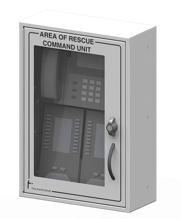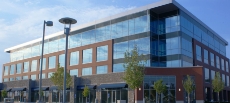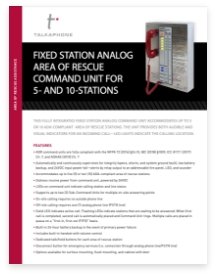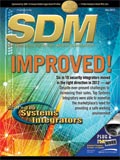 If you ask 12 different security people what “entry control” means, you will likely get 12 different answers. Perhaps the term is not that widely used in the industry; but when you think about what it really means, it is an invaluable set of products or systems for almost every type of facility that uses access control. There is not a system or single type of product that constitutes entry control, but rather a common purpose to be able to communicate with — and often see — the person on the other side of the door or gate before letting them on the premises.
If you ask 12 different security people what “entry control” means, you will likely get 12 different answers. Perhaps the term is not that widely used in the industry; but when you think about what it really means, it is an invaluable set of products or systems for almost every type of facility that uses access control. There is not a system or single type of product that constitutes entry control, but rather a common purpose to be able to communicate with — and often see — the person on the other side of the door or gate before letting them on the premises.
From small businesses to enterprise-level systems, access control is becoming a necessity. Schools that never worried about it before are locking their doors after high-profile tragedies. Small businesses no longer take an open-door policy for granted. Enterprise systems are looking for seamless integrated security for all. Everywhere, doors are being secured and employees being issued access credentials. But for all of these facilities, higher security means locked gates and controlled doors and the need to somehow manage entry for everyone else that doesn’t work there. How do you do that?
The answer is entry control.
Defining Entry Control
Entry control is not the same thing as access control, intercoms, phone entry or video. But it often incorporates many or all of these technologies.
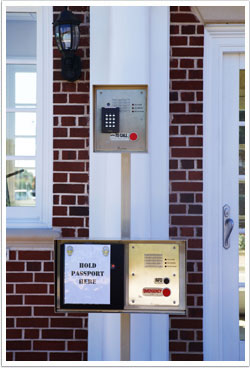 “Most doors or entrances and exits that used to be freely opened are now locked,” says John Mosebar, vice president of marketing, Aiphone Corp., Bellevue, Wash. “Now there is some kind of access control identification credential; and there is audio and video surveillance and/or communication. These things typically will make up an entry control solution.”
“Most doors or entrances and exits that used to be freely opened are now locked,” says John Mosebar, vice president of marketing, Aiphone Corp., Bellevue, Wash. “Now there is some kind of access control identification credential; and there is audio and video surveillance and/or communication. These things typically will make up an entry control solution.”
Richard Sedivy, director of marketing, DoorKing Inc., Inglewood, Calif., suggests considering whether communication is needed.
“Does the facility have to accommodate visitors to the controlled area? If they do, then you need some sort of communication from the entry point to the facility so they control or deny access.”
The primary means of communicating and granting access are either through a telephone entry system or intercom. But entry control systems don’t stop there. More and more often these days they incorporate video and more.
“Most will have access, alarm, CCTV and intercom systems combined,” says Michael Kielbasa, security division manager for MidCo Inc., a Burr Ridge, Ill.-based integrator. “Whether small, medium or large, most organizations tend to be going with those four systems and integrating them together in some fashion. That is what I would call entry control. When the element of access control comes in they want the ability to carry ID badges and cards. Once they do that, they need a way [for non-employees] to identify themselves and get in.”
As more and more companies look for ways to reduce manpower and use technology to its fullest advantage, entry control systems will become increasingly sought after, adds John LaFond, vice president of integrated systems, Linear LLC, Carlsbad, Calif. “Any time you can deploy a technology that provides unattended screening of individuals coming into a facility that also helps create more efficiency as an organization, the customer will save money in the long term.”
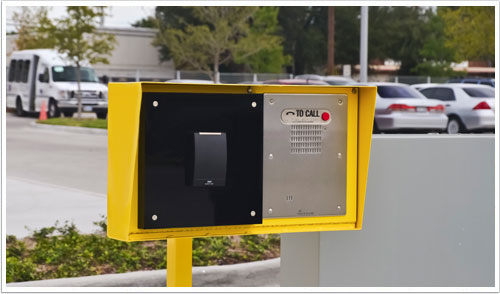
Designing Entry Control
Within the four most common elements of entry control — access, alarm, CCTV and communication — there is a lot of leeway on how to get there. While access and alarms make up part of these systems, the communication and video elements are the primary differentiators that allow these systems to function as they need to for non-employees and employees alike.
When it comes to the communication side of things, the two main technologies involved are intercoms and phone entry.
Many intercom systems incorporate cameras right into the unit,” Mosebar says. “Basically it is like a doorbell buzzer built into an enclosure that also has an intercom or two-way audio and typically a video camera all in one compact device that allows for viewing and audio at very close range.”
Some of the more recent developments in these products include larger screens and touch screen control, as well as cameras with pan-tilt-zoom, Mosebar adds.
Intercom technology can be one-to-one, or one-to-several, LaFond explains, whereas telephone entry can be one-to-many. “Within the telephone entry segment, you actually have an element that allows you to view criteria associated with who you are visiting and look up names. It gives you a little more interface.”
Telephone entry systems are often used in multi-tenant facilities, condominiums and apartments, but can also be used in commercial settings.
“Most of this technology in the commercial segment is out at the edge,” LaFond adds. “You want people to be able to ring to someone at a particular location and gain access, but in cases of unattended applications the technology is out at the gate prior to entry. So someone might roll up and there are 20 different businesses at a facility with a shared underground parking garage. They scroll through an LCD screen that would say building five and press the call button to ring someone at that location to have a conversation and be granted access.”
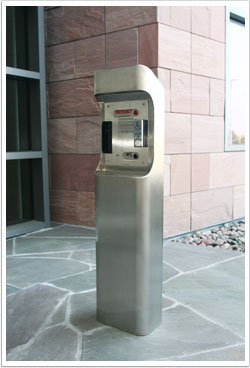 Intercoms and telephone entry are two very different devices, Sedivy explains. “They both communicate from point A to point B, but typically the intercom system really is not an access control system. There may be some basic functionality there but it is hardwired point to point. Telephone entry systems provide communication via the telephone company or voice over IP (VoIP) and these devices can also be full blown access control systems. The only difference between these and an access control system is that access control doesn’t have a communication path. Telephone entry adds that one other element.”
Intercoms and telephone entry are two very different devices, Sedivy explains. “They both communicate from point A to point B, but typically the intercom system really is not an access control system. There may be some basic functionality there but it is hardwired point to point. Telephone entry systems provide communication via the telephone company or voice over IP (VoIP) and these devices can also be full blown access control systems. The only difference between these and an access control system is that access control doesn’t have a communication path. Telephone entry adds that one other element.”
In addition, video is becoming a more popular add-on to telephone entry control systems, Sedivy adds.
“Telephone entry systems can incorporate built-in video or stand-alone video alike,” says Samuel Shanes, chairman, Talkaphone Co., Niles, Ill. “We have two distinct product lines. One is analog, using POTS lines and the other is VoIP, which goes on the network and ties in to a PBX system like Cisco or Avaya. Video is typically managed via the video management platform of the client’s choice.”
Video is important to a lot of entry control applications, adds David Roberts, senior vice president, Advanced Cabling Systems, North Little Rock, Ark. “The reason to have video on a door is because you can’t see what is going on there. We see it a lot on shipping or receiving docks, back doors and drive-up gates. They want to both talk back and forth and see who is there.”
A large part of what dictates the type of communication (and video) used is the size and type of facility, Kielbasa says. “At the very simplest there are intercom systems, a lot of which have cameras tied in with them. The majority of systems we install are video intercom systems with a built-in camera.”
Larger facilities tend to get away from the all-in-one solutions in favor of using their enterprise systems and their individual components in a specific entry control setting. “Here we would integrate video, access control and intercom to work in unison and build a system. These have to operate on a network and talk seamlessly to each other. There are different head ends that tie to the customer’s network. Everything is event driven.”
Shanes agrees. “We are able to be a part of a total security system no matter how small or large. Bigger clients will have a truly scalable surveillance system in place that could easily include hundreds or thousands of cameras. They will want their own cameras doing surveillance and possibly analytics. Our communication platform will integrate on the video management system of their choice.”
It is somewhat ironic that some of the oldest technologies (intercoms and phones) are not only still around, but still being actively sought after for entry control, Mosebar says. “I have been with this company for 30 years and you would think the intercom term would be antiquated and have been replaced with some other technology. It is surprising that these technologies are still alive and well. With that said, we just have to keep adopting and bringing in new features and functions that end users need to enhance their physical security.”
New and Noteworthy
IP, cell phones, analytics and integration are some of the top trends happening now or just beginning to be part of the entry control arena.
While POTS is still the simplest and most economical method of phone communication today, more and more users are turning to VoIP devices, says Richard Sedivy, DoorKing. “We are seeing a little of that now, but not a lot because of limitations on VoIP. The other thing we are seeing is cellular-based phone entry systems. People ask about it but quite frankly it still comes down to cost.”
Everything is going to IP-based systems in the security industry, adds Samuel Shanes, Talkaphone. “Entry control systems are no exception. Basically, entry control follows the trends of the security market in general, which in turn follows global IT. Everything is going to IP, which will involve VoIP and the SIP protocol on the communications side. IT doesn’t want to maintain old technology like POTS lines. We will continue to see more of that, as well as convergence with video management platforms, surveillance cameras, access control, mass notification and business continuity systems.”
Fred Zimmermann, vice president, Essex Electronics, Carpinteria, Calif., agrees. “Most of it is going to be IP-based. IP has become quite popular. Everyone wants to have access control over the Internet. Systems that allow you to talk to your door over the Internet are very appealing.”
Michael Kielbasa, MidCo Inc., is seeing more use of video analytics in entry control. “The latest trends we see, especially in larger systems, is the use of analytics in camera systems to see people approaching doors or buildings,” he says. “An event is created prior to a person even hitting the entry button.”
Beyond that, systems are headed for more integration, he adds. “We are going to see the smallest of businesses tightening their facilities more and more and therefore we expect big growth for access control.” And by extension, entry control: “Almost everything we sell has the four elements, addressing entry control plus a lot of other things.”
This article originally appeared in the July 2013 issue of the SDM magazine, by Karyn Hodgson. Full article can be found at www.sdmmag.com
